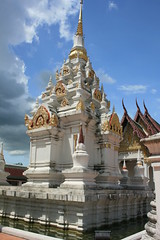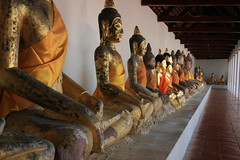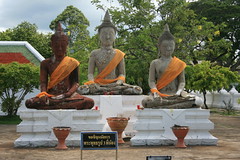 Wat Phra Boromathat Chaiya Rat Worawihan (วัดพระบรมธาตุไชยาราชวรวิหาร) is the most important Buddhist temple of Surat Thani, and also one of the most beautiful ones. The central chedi in Srivijaya style with its many golden ornaments is even the iconic symbol of the province Surat Thani.
Wat Phra Boromathat Chaiya Rat Worawihan (วัดพระบรมธาตุไชยาราชวรวิหาร) is the most important Buddhist temple of Surat Thani, and also one of the most beautiful ones. The central chedi in Srivijaya style with its many golden ornaments is even the iconic symbol of the province Surat Thani.The reason why the main temple of the province is not located in the provincial capital lies in the history of the province. In fact, the temple was originally in the capital of the Mueang Chaiya, one of the semi-independent city-states which made up Siam until the administrative system was completely overhauled at the begin of the 20th century. Though by then the town Chaiya was moved closer to the sea to present-day Phum Riang - it came back to its original location after the railway was built in 1915. However, by then the province Surat Thani was established by merging the area formerly under Chaiya with the one under Kanchanadit, and the new center of the province was at the mouth of the Tapi river in Ban Don.
 Every side of the chedi shows a different ornament, though I don't know much about the actual meaning. Pointing north is a peacock, to the south is Erawan as the multi-headed elephant, to the east a Buddha surrounded by regalia which reminded me of the old coat of arms of Siam. The one on the west side I could not recognize at all. The chedi is surrounded by a walkway with lots of Buddha statues, and several smaller chedis, elephant and other statues, as well as nice small trees. If only it were not so hot and sunny, which made walking around on the hot plaster barefooted far from comfortable.
Every side of the chedi shows a different ornament, though I don't know much about the actual meaning. Pointing north is a peacock, to the south is Erawan as the multi-headed elephant, to the east a Buddha surrounded by regalia which reminded me of the old coat of arms of Siam. The one on the west side I could not recognize at all. The chedi is surrounded by a walkway with lots of Buddha statues, and several smaller chedis, elephant and other statues, as well as nice small trees. If only it were not so hot and sunny, which made walking around on the hot plaster barefooted far from comfortable.Much less spectacular than the chedi is the bot, though religiously it is the more important building. Inside are just several smaller Buddha statues, and no murals at the walls.
 The three Buddha statues outside next to the Bot are also notable. Normally Buddha statues are always under a roof protected from the elements, however these three are believed to prefer to stay outside - when they were placed under a roof in past, lightning struck and destroyed the building. I don't know if and when this story actually took place, but it sounds like a perfectly fit explanation for these statue's location.
The three Buddha statues outside next to the Bot are also notable. Normally Buddha statues are always under a roof protected from the elements, however these three are believed to prefer to stay outside - when they were placed under a roof in past, lightning struck and destroyed the building. I don't know if and when this story actually took place, but it sounds like a perfectly fit explanation for these statue's location.Directly at the temple is also a local branch of the National Museum, which has several items from the Srivijaya times on display. Sadly not allowing photography I did skip the revisit and focused on taking photos of the temple instead. Since I did quite a lot of photos, like the views of the chedi from all four sides, I uploaded the whole collection to flickr.




















